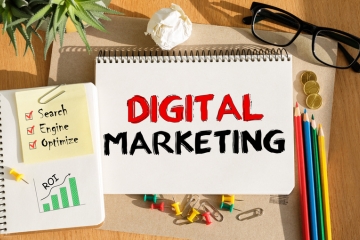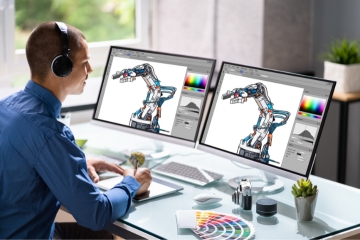
The Future of Augmented Reality (AR) and Virtual Reality (VR) in App Development
At V1 Academy, we constantly monitor emerging technologies and their impact on the Mobile App Development, Web Development, and Website Design landscape. Among the most transformative technologies we observe are Augmented Reality (AR) and Virtual Reality (VR). Both AR and VR are rapidly influencing how developers create digital experiences, and their presence is becoming indispensable across industries. In this article, we will explore the future of AR and VR in App Development, discuss their profound potential, and highlight how they are reshaping Website Development and user interaction.
A Brief Overview: Understanding AR and VR
Before diving into the future of AR and VR, it is crucial to clarify what these technologies encompass and how they differ.
What is Augmented Reality (AR)?
Augmented Reality (AR) enhances the real-world environment by overlaying digital elements, such as images, sounds, or other sensory information, onto physical surroundings. The technology typically operates through smartphones, tablets, or AR glasses. Users maintain a clear view of their environment, augmented by helpful virtual additions, improving their interaction with the physical and digital worlds.
What is Virtual Reality (VR)?
Virtual Reality (VR) immerses users in a fully digital world. Using VR headsets and controllers, users are transported to a simulated environment, which can be a recreation of a real-world location or a purely imaginative space. VR replaces the physical surroundings entirely, creating an interactive and immersive experience that is ideal for gaming, training simulations, virtual tours, and more.
The Role of AR and VR in Mobile App Development
At V1 Academy, we believe that AR and VR will become central to Mobile App Development. As these technologies advance, developers have the ability to create more immersive, interactive, and engaging applications that blend the digital and physical worlds.
Enhanced User Interaction and Engagement
One of the most significant impacts of AR and VR on Mobile App Developmentis the potential to dramatically enhance user interaction. With AR, users can interact with digital elements in real time, whether it's through virtual objects superimposed in the real world or digital interfaces that respond to their physical movements. This opens up endless possibilities for creating highly personalized user experiences. For instance, mobile AR apps in retail allow users to "try on" clothes or accessories virtually, leading to greater engagement and reducing return rates.
VR takes this a step further, providing fully immersive environments where users can explore, learn, or even play in a simulated setting. VR's role in App Development has been particularly beneficial in industries such as gaming, real estate, and education, where virtual simulations offer users a deeper, more interactive experience than traditional apps.
Expanding Opportunities in E-Commerce and Retail
AR and VR are particularly poised to revolutionize the e-commerce and retail industries. With AR, users can now visualize how products will look and function in their own homes or even on their own bodies before making a purchase. This "try-before-you-buy" model has already been adopted by major brands and is proving to be highly effective in reducing product returns and improving user satisfaction.
For App Development, this trend is creating new opportunities for developers to build e-commerce apps that integrate AR features. For example, AR-enabled apps can allow users to see how furniture fits into a room or test how new shoes look with their wardrobe. As Mobile App Development increasingly adopts AR, we foresee a substantial shift in the way consumers interact with online retailers.
Revolutionizing Learning and Training Applications
In the fields of education and training, AR and VR are game-changers. AR allows learners to access contextual information overlaid on their physical environment, which can lead to more interactive and effective learning experiences. Educational apps that leverage AR provide students with 3D models of historical artifacts, or scientific simulations, creating a dynamic and interactive way to learn.
VR goes further by immersing students in entirely new worlds. Imagine taking a virtual field trip to a distant country or simulating complex surgical procedures without leaving the classroom. This capability is already being integrated into educational platforms, and Mobile App Development is beginning to capitalize on this, creating a new generation of immersive educational tools that bring learning to life.
AR and VR's Role in Web and Website Development
Beyond Mobile App Development, AR and VR are also transforming Web Development and Website Design. As users demand more immersive and interactive web experiences, developers are finding innovative ways to incorporate AR and VR technologies into website interfaces.
Transforming Website User Interfaces
AR can significantly enhance Website Design by integrating real-time interaction into the user's browsing experience. For instance, websites can use AR to allow users to interact with 3D models of products directly on the website, offering a more engaging and hands-on experience than static product images.
In the context of Website Development, creating an AR-enabled site requires careful planning and advanced technical skills to ensure that the site functions seamlessly across devices. However, the benefits of this added layer of interactivity can result in higher user engagement and increased conversions.
Virtual Reality for Immersive Website Experiences
While still in its infancy, VR in Website Development offers a glimpse into the future of fully immersive web browsing. VR can turn websites into fully interactive experiences where users can "enter" virtual environments, engage with digital products, or even participate in virtual meetings. As VR technology continues to develop, we expect Web Development to evolve, with websites transitioning from flat, 2D designs to fully immersive virtual spaces.
Integrating AR and VR for Real-Time Feedback and Interaction
For businesses looking to improve user feedback mechanisms, AR and VR provide excellent tools. AR apps, integrated into websites, can offer users the ability to provide real-time feedback on digital products by interacting with them in real-world settings. Similarly, VR can be used to create virtual focus groups or user-testing environments where businesses can gather data on how users interact with their products in simulated settings.
Incorporating these features into Website Design not only enriches the user's experience but also provides valuable insights that can be used to refine product offerings and marketing strategies.
Challenges in AR and VR Integration
At V1 Academy, we understand that integrating AR and VR into App Development and Website Development is not without its challenges. Although the potential is vast, developers face several hurdles that must be addressed for successful implementation.
Technical Limitations
Despite their rapid development, AR and VR technologies are still heavily reliant on hardware. Users need specific devices, such as smartphones with AR capabilities or VR headsets, to access these experiences. Additionally, the development of high-quality AR and VR applications requires expertise in specialized programming languages and frameworks, as well as access to powerful processing capabilities to ensure smooth and responsive interactions.
For developers, overcoming these technical challenges is key to unlocking the full potential of AR and VR in App Development and Website Development.
User Accessibility and Experience
Another challenge lies in ensuring that AR and VR experiences are accessible to all users. Not everyone owns or can afford the latest VR headset, and some users may experience discomfort, such as motion sickness, when using VR applications. For AR, ensuring the user interface is intuitive and not overwhelming is crucial for maintaining a seamless experience.
Developers must consider these factors during the App Development and Website Design process to ensure that their AR and VR solutions are both user-friendly and accessible to a broad audience.
Future Trends in AR and VR for App and Web Development
As AR and VR technologies continue to mature, V1 Academy predicts several key trends that will shape the future of App Development and Website Development/p>
AR and VR in 5G-Enabled Mobile Applications
The rollout of 5G networks is set to significantly enhance the capabilities of AR and VR in Mobile App Development. With faster internet speeds and reduced latency, AR and VR apps will become more responsive, providing real-time experiences that were previously impossible. This will allow developers to create more interactive and immersive mobile applications that can handle complex tasks like multiplayer AR games or large-scale VR simulations.
The Rise of Mixed Reality
Mixed Reality (MR) is the next evolution of AR and VR, combining elements of both to create an even more immersive experience. In MR, digital and physical worlds are merged, allowing users to interact with both simultaneously. This trend is expected to take off in the coming years, and App Development professionals will need to adapt their strategies to take advantage of this new hybrid technology.
More Affordable and Accessible AR/VR Devices
As AR and VR technologies become more mainstream, we expect to see a greater variety of affordable devices hitting the market. This will make AR and VR experiences more accessible to a wider audience, increasing the demand for AR and VR-enabled applications in Website Development and App Development.
Conclusion
At V1 Academy we believe that the future of Mobile App Development, Web Development, and Website Design will be defined by the rise of Augmented Reality (AR) and Virtual Reality (VR). These technologies offer unparalleled opportunities for creating immersive, interactive, and engaging digital experiences. While there are challenges in terms of technical limitations and user accessibility, the potential benefits far outweigh these hurdles.
As AR and VR continue to evolve, businesses that embrace these technologies will gain a competitive edge, offering their users cutting-edge experiences that transcend traditional digital interactions. By staying informed and adaptable, developers and businesses alike can capitalize on the future of AR and VR, driving innovation across the App Development and Website Development landscapes.
At V1 Academy, we are committed to keeping you at the forefront of these emerging trends.

He Laughed at My Computer Skills—Now He Asks Me for Help!

Warning: Skipping These PHP Tricks Might RUIN Your Web Development Career!

Instagram Likes Won’t Pay Your Bills—But This Digital Skills Will!

Your Brain Is Screaming for an Upgrade—Are You Ready for It?

From Beginner to Expert: How Basic Computer Skills Can Open New Opportunities

I Was Lost in My Career Until I Found Digital Marketing- Here's How it Transformed Me

Breaking the Middle-Class Mindset: Yes, Graphic Design Can Be a High-Paying Career

Breaking the ‘Non-IT Background’ Barrier: How Anyone Can Become a Developer with the Right Guidance

Graphic Design for Real-World Impact: Learn How to Build Apps, Brands, and Your Dream Career

Code Your Way to Confidence: How Programming Courses in West Bengal Are Giving Youngsters a Sense of Purpose

From Villages to Cities: How Basic Computer Courses Are Uniting and Empowering West Bengal

Break the 9-to-5 Cycle: Learn Digital Marketing and Create Your Own Path to Success in West Bengal